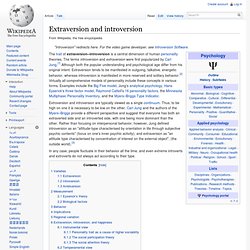

Extroversion and introversion. The trait of extraversion–introversion is a central dimension of human personality theories.

The terms introversion and extraversion were first popularized by Carl Jung,[1] Although both the popular understanding and psychological age differ from his original intent. Extraversion tends to be manifested in outgoing, talkative, energetic behavior, whereas introversion is manifested in more reserved and solitary behavior.[2] Virtually all comprehensive models of personality include these concepts in various forms. Examples include the Big Five model, Jung's analytical psychology, Hans Eysenck's three-factor model, Raymond Cattell's 16 personality factors, the Minnesota Multiphasic Personality Inventory, and the Myers–Briggs Type Indicator.
In any case, people fluctuate in their behavior all the time, and even extreme introverts and extroverts do not always act according to their type. Varieties[edit] Mutable sign. Mutable sign: A sign that can be adjustable, understanding, analyser, extrovert.

The sign that comes under the mutable section can be associated with the positive qualities as it can act on any sides of Cardinal as well as the Fixed signs. The mutable signs are: For more information, refer to the Astrological Signs article. Historical definitions[edit] In a Byzantine scholium to Chapter 2 of the Introduction to astrology by fourth-century late Roman astrologer Paulus Alexandrinus, the following clear definition can be found: Aquarius 11th. Sagittarius (astrology)